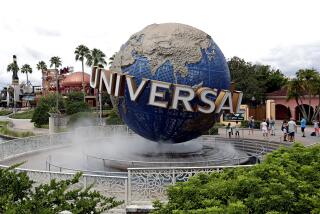Building a Better Mouse : Boost at Flagship Park Could Aid All of Disney
- Share via
On paper, it would seem that Disneyland is an inconsequential part of a giant corporation. The Anaheim park now accounts for a small share of Walt Disney Co.’s theme park business, which itself made up just one-third of the company’s overall business.
But in many ways, Disneyland remains the bedrock of the $12-billion corporation. Disneyland is where it all started, and analysts say Burbank-based Disney has sound financial reasons to protect and build on its flagship enterprise with Wednesday’s announcement of a second theme park, Disney’s California Adventure.
For 41 years, Disneyland has been a sturdy, dependable source of revenue for the company, and it figures to be more important as Disney continues to expand into more risky ventures such as movie-making.
More than 350 million people have passed through the gates of the Magic Kingdom, including a record 14.1 million last year.
Its influence on the company’s other main businesses--television and filmed entertainment, and consumer products--is immeasurable. The park is a core element of Disney’s synergistic marketing; many of the same people who visit the park wear Disney clothes, subscribe to the Disney Channel and buy Disney videotapes.
“It all fits together, it’s all part of the same package,” said Harold Vogel, a Disney analyst at Cowen & Co. in New York. “They have to continue to grow [Disneyland] to keep market share and brand presence.”
*
By adding a second theme park next to Disneyland and converting the area into a resort center with a new luxury hotel and retail esplanade, Disney hopes to establish a worldwide destination much like Disney World in Orlando, a place drawing more people of all ages and lengthening visitors’ stays, from the current day or two at most to several days.
“The way to make serious money is to get people to come to your site and stay there for a long time and spend all their money on you,” said David Koenig, author of “Mouse Tales: A Behind the Ears Look at Disneyland.”
Koenig and other analysts don’t believe it’s possible for Disney to match the success it has had at Disney World, which drew more than twice the number of visitors that Disneyland did last year.
Disney World is on 29,000 acres, compared with the 330 acres Disney owns in Anaheim. Disney World operates three theme parks, and a fourth--Disney’s Animal Kingdom--is slated to open in 1998. Its Florida resort includes several hotels and villas, campgrounds, golf courses, conference centers and other recreational facilities. Its Pleasure Island area has half a dozen nightclubs and places for adults to eat and drink.
It’s no wonder, then, that out-of-town visitors to Orlando typically stay for five days, whereas Disneyland is generally a single-day trip.
“The lesson they learned in Orlando is that you try to sell seven days of experience as opposed to seven hours,” said Ray Braun, senior vice president at Economics Research Associates, a Los Angeles consultant to the amusement park industry.
Disney, of course, faces much more competition in Southern California than it does in central Florida. Disney can’t expect to keep visitors ensconced in Anaheim, not with the beaches, Hollywood and other attractions in the region beckoning.
Even so, with a second gate in the new California Adventure park and shopping and nighttime entertainment, analysts say, Disney and its Anaheim hotels could be the “headquarters” of a visitor’s multiple-day trip to the Southland, whereas now people could stay anywhere in the region and come to Anaheim for a day at Disneyland.
*
“We’ll see an increase in international guests,” predicted Jack Lindquist, Disneyland’s president from 1989 to 1993. Historically, about 40% of Disneyland’s visitors have come from outside California, he said.
Lindquist doesn’t see the mix of visitors to Disneyland changing--75% adults, 25% children. But he says the addition of restaurants and other entertainment will keep conventioneers and other adults in Anaheim through the night--reflecting a resort area’s urban, edgier feel not unlike MCA’s City Walk in Universal Studios that is aimed at attracting more than just families with children.
Lindquist, who started at Disneyland as marketing director when the park opened, has followed the corporation’s gradual shift to non-theme park entertainment, none more notable than last year’s multibillion-dollar merger with Capital Cities/ABC. And in recent years Disney’s theme park operations have lagged the revenue growth of its two other business segments.
But Lindquist believes Disneyland and its future are crucial to Disney because Southern California is home to the corporation and the region remains one of the world’s biggest tourism markets.
Then there’s the Disneyland legacy.
“This is the park that Walt [Disney] built and the only one he ever saw,” Lindquist said. “This park has and will be a very critical part of Walt Disney Co.”
Harrison Price, a San Pedro-based consultant who has done work for Disney over the years, says he has long encouraged the company to expand in the Disneyland area.
“You keep expanding or you wither,” he said. “Look at Florida.
“Florida started out with a big gate just like Disneyland. By adding additional gates and expansion, they’ve added another 25 million in attendance. It would be a mistake strategically not to do it.”
* WALT’S PLACE EXPANDS
Disneyland will be joined by a California-themed park. A1
(BEGIN TEXT OF INFOBOX / INFOGRAPHIC)
The Amusement Giant
Walt Disney Co.’s theme park-resort operations provided about one-third of the corporation’s $12.1 billion in revenue and $2.5 billion operating income last year. In fact, Disney’s four U.S. parks were the most frequently attended in the United States in 1995:
Revenue Division
Filmed entertainment: 49%
Theme parks/resorts: 33
Consumer products: 18
Operating Income*
Filmed entertainment: 44%
Theme parks/resorts: 35
Consumer products: 21
* Income minus expenses, but before taxes and extraordinary items
Amusement Park Attendance
Rounded figures for 1995, in millions, are industry estimates because parks do not release totals.
*--*
Park Location Visitors 1. Disneyland Anaheim 14.1 2. The Magic Kingdom/Walt Disney World Lake Buena Vista, Fla. 12.9 3. Epcot/Walt Disney World Lake Buena Vista, Fla. 10.7 4. Disney-MGM Studios/Walt Disney World Lake Buena Vista, Fla. 9.5 5. Universal Studios Florida Orlando, Fla. 8.0 6. Sea World of Florida Orlando, Fla. 5.0 7. Universal Studios Hollywood Universal City 4.7 8. Six Flags Great Adventure Jackson, N.J. 4.0 9. Busch Gardens Tampa Tampa, Fla. 3.8 10. Sea World of California San Diego 3.8
*--*
Note: Knott’s Berry Farm ranked 13th, with 3.4 million
Mickey’s Worldwide Reach
From a single location in Anaheim, Disney theme parks have expanded worldwide:
Park / Date opened
Disneyland: July 17, 1955
Magic Kingdom at Walt Disney World: Oct. 1, 1971
Epcot Center: Oct. 1, 1982
Tokyo Disneyland*: April 15, 1983
Disney-MGM Studios Theme Park: May 1, 1989
Disneyland Paris (formerly Euro Disney)**: April 12, 1992
* Owned and operated by a Japanese corporation paying royalties to Walt Disney Co.
** Majority owner is Euro Disney S.C.A., in which Disney has a 39% ownership.
Sources: Amusement Business magazine, Walt Disney Co., Times reports; Researched by JANICE L. JONES / Los Angeles Times
More to Read
Inside the business of entertainment
The Wide Shot brings you news, analysis and insights on everything from streaming wars to production — and what it all means for the future.
You may occasionally receive promotional content from the Los Angeles Times.











